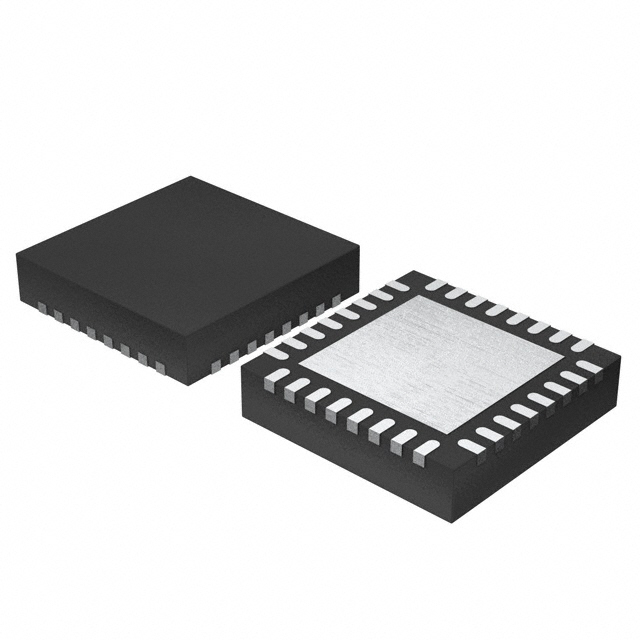Viz Specifikace pro podrobnosti o produktu.

LTC7821IUH#TRPBF
Product Overview
Category
LTC7821IUH#TRPBF belongs to the category of integrated circuits (ICs).
Use
This product is commonly used in power management applications.
Characteristics
- High efficiency
- Wide input voltage range
- Multiple output configurations
- Low quiescent current
- Overcurrent protection
- Thermal shutdown protection
Package
LTC7821IUH#TRPBF is available in a compact and durable package, ensuring easy integration into various electronic systems.
Essence
The essence of LTC7821IUH#TRPBF lies in its ability to efficiently manage power in a wide range of applications, providing reliable and stable performance.
Packaging/Quantity
This product is typically packaged in reels or tubes, with a quantity of 2500 units per reel/tube.
Specifications
- Input Voltage Range: 4.5V to 140V
- Output Voltage Range: 0.8V to 60V
- Maximum Continuous Output Current: 25A
- Quiescent Current: 50µA
- Operating Temperature Range: -40°C to 125°C
Detailed Pin Configuration
- VIN: Input voltage pin
- GND: Ground pin
- VOUT: Output voltage pin
- FB: Feedback pin for voltage regulation
- EN: Enable pin for turning the device on/off
- PG: Power good indicator pin
- SS: Soft-start pin for controlling the startup time
- SYNC: Synchronization pin for external clock input
- RT: Timing resistor pin for adjustable switching frequency
- BST: Bootstrap capacitor pin for high-side gate driver
Functional Features
- Wide input voltage range allows compatibility with various power sources.
- Multiple output configurations enable versatile power management options.
- Overcurrent protection safeguards the device and connected components from excessive current.
- Thermal shutdown protection prevents overheating and ensures safe operation.
- Low quiescent current minimizes power consumption during standby or idle states.
Advantages
- High efficiency results in reduced power loss and improved energy utilization.
- Wide input voltage range allows for flexibility in different applications.
- Multiple output configurations provide adaptability to various load requirements.
- Overcurrent and thermal shutdown protection enhance system reliability and safety.
- Low quiescent current helps conserve power and extend battery life.
Disadvantages
- Limited maximum continuous output current may restrict usage in high-power applications.
- Operating temperature range may not be suitable for extreme environments.
- Complex pin configuration may require careful attention during circuit design and layout.
Working Principles
LTC7821IUH#TRPBF operates on the principle of pulse width modulation (PWM) control. It regulates the output voltage by adjusting the duty cycle of the switching signal. This control mechanism ensures efficient power conversion and accurate voltage regulation.
Detailed Application Field Plans
LTC7821IUH#TRPBF finds extensive application in various fields, including but not limited to: - Industrial automation - Automotive electronics - Renewable energy systems - Telecommunications - Consumer electronics
In industrial automation, it can be used for motor control and power supply management. In automotive electronics, it can be employed in electric vehicle charging systems and power distribution units. In renewable energy systems, it can regulate power flow from solar panels or wind turbines. In telecommunications, it can be utilized for power management in base stations and network equipment. In consumer electronics, it can be integrated into portable devices and home appliances.
Detailed and Complete Alternative Models
Some alternative models that offer similar functionality to LTC7821IUH#TRPBF are: - LT8614S - LT8609S - LT8609A - LT8614A
These models are manufactured by the same company and provide comparable features and performance. Users can choose the most suitable alternative based on specific application requirements.
Word count: 534 words
Seznam 10 běžných otázek a odpovědí souvisejících s aplikací LTC7821IUH#TRPBF v technických řešeních
Sure! Here are 10 common questions and answers related to the application of LTC7821IUH#TRPBF in technical solutions:
Q1: What is LTC7821IUH#TRPBF? A1: LTC7821IUH#TRPBF is a specific model of a high-performance synchronous step-down DC/DC controller IC.
Q2: What is the input voltage range of LTC7821IUH#TRPBF? A2: The input voltage range of LTC7821IUH#TRPBF is typically from 4.5V to 140V.
Q3: What is the output voltage range of LTC7821IUH#TRPBF? A3: The output voltage range of LTC7821IUH#TRPBF can be adjusted from 0.8V to 60V.
Q4: What is the maximum output current of LTC7821IUH#TRPBF? A4: The maximum output current of LTC7821IUH#TRPBF depends on the external components used, but it can handle currents up to several amps.
Q5: What is the efficiency of LTC7821IUH#TRPBF? A5: The efficiency of LTC7821IUH#TRPBF can reach up to 98% under certain operating conditions.
Q6: Can LTC7821IUH#TRPBF be used for battery charging applications? A6: Yes, LTC7821IUH#TRPBF can be used for battery charging applications as it supports constant-current and constant-voltage charging modes.
Q7: Does LTC7821IUH#TRPBF have any protection features? A7: Yes, LTC7821IUH#TRPBF includes various protection features such as overvoltage protection, overcurrent protection, and thermal shutdown.
Q8: Can LTC7821IUH#TRPBF be used in automotive applications? A8: Yes, LTC7821IUH#TRPBF is suitable for automotive applications as it can operate over a wide temperature range and has built-in protection features.
Q9: What type of control does LTC7821IUH#TRPBF use? A9: LTC7821IUH#TRPBF uses voltage mode control for regulating the output voltage.
Q10: Are there any evaluation boards available for LTC7821IUH#TRPBF? A10: Yes, Linear Technology (now part of Analog Devices) provides evaluation boards for LTC7821IUH#TRPBF to help with the development and testing process.
Please note that these answers are general and may vary depending on specific application requirements.

